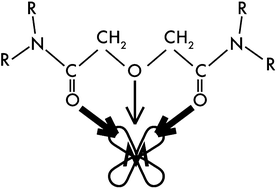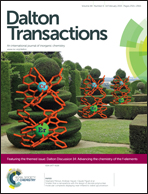The selectivity of diglycolamide (TODGA) and bis-triazine-bipyridine (BTBP) ligands in actinide/lanthanide complexation and solvent extraction separation – a theoretical approach†‡
Abstract
Theoretical calculations (density functional theory with the scalar relativistic ZORA Hamiltonian) have been performed to obtain the energy and Gibbs free energy of formation of cationic 1 : 3 complexes of americium(III) and europium(III) with a tri-O-dentate diglycolamide ligand TEDGA (a model of TODGA extractant), as well as the free energy of their partition between water and an organic diluent. The distribution of electron density over the atoms, bonds, and molecular orbitals was analyzed by means of Mulliken population analysis, the localization procedure of natural bond orbitals, and the Quantum Theory of Atoms-in-Molecules. The stabilities of both [M(TEDGA)3]3+ complexes are similar to each other. On the other hand, our recent data for a similar pair of cationic Am/Eu complexes with a softer (HSAB) tetra-N-dentate ligand C2-BTBP show that the [Am(C2-BTBP)2]3+ complex is significantly more stable in aqueous solution than its Eu counterpart. The decisive factor stabilizing the Am3+ complexes over their Eu3+ analogues is the charge transfer from the ligands, somewhat greater on the 6d(AmIII) than on 5d(EuIII) orbitals. The covalency of M–N bonds in the [M(C2-BTBP)2]3+ complexes is greater than that of M–O bonds in [M(TEDGA)3]3+, but the latter is not negligible, in particular in the bonds with the oxygen atoms of the amide groups in TEDGA. The analysis of charge distribution over the whole molecules of the complexes shows that the TEDGA molecule is not hard as expected, but a relatively soft Lewis base, only slightly harder than BTBP. This conclusion has been confirmed by the calculation of the chemical hardness of the ligands. Moreover, the comparison of the results of bonding analysis with the calculated energies of complex formation in water and in the gas phase allows us to conclude that the population analysis, QTAIM topological parameters, and SOPT stabilization energy, as well as Wiberg and overlap-weighted NAO indices are the tools for analyzing the covalency rather than the total bond strength.

- This article is part of the themed collection: Dalton Discussion 14: Advancing the chemistry of the f-elements

 Please wait while we load your content...
Please wait while we load your content...